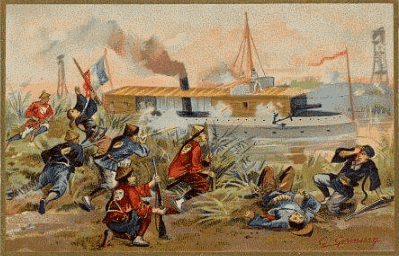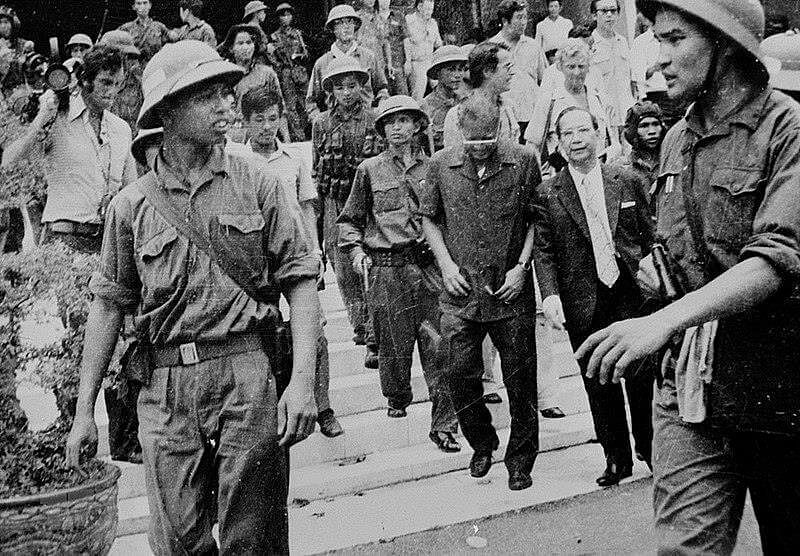Class 10 Exam > Class 10 Notes > History for Class 10 > Key Concepts: The Nationalist Movement in Indo-China
Key Concepts: The Nationalist Movement in Indo-China | History for Class 10 PDF Download
SECTION A —
EMERGING FROM THE SHADOW OF CHINA THE DILEMMA OF COLONIAL EDUCATION AND HYGIENE, DISEASE AND EVERYDAY RESISTANCE:
 Fig: The conquest and colonisation of Vietnam
Fig: The conquest and colonisation of Vietnam
- Indo-China comprises the modern countries of Vietnam, Laos and Cambodia.
- Vietnam followed a Chinese system of government as well as Chinese culture.
- The French colonised Vietnam. After defeating China, they assumed control of Tonkin and Anaam.
- In 1887, French Indo-China was formed.
- Colonies were considered essential to supply natural resources and other essential goods. The French built infrastructure projects to help transport goods for trade, move military garrisons and control the entire region.
- The colonial economy in Vietnam was based on rice cultivation and rubber plantations. Very little industrialisation of Vietnam by France.
- To counter Chinese influence, the French systematically dismantled the traditional educational system and established French schools for the Vietnamese.
- The textbooks glorified French rule and culture.
- Students fought against discrimination against the Vietnamese in white collar jobs. Schools became important place for cultural and political battles. Education became an important part of the larger battle against colonialism and for independence.Question for Key Concepts: The Nationalist Movement in Indo-ChinaTry yourself:What was the main reason for the French colonization of Vietnam?View Solution
- In 1902, the French part of Hanoi was hit by a rat menace. Vietnamese were paid to catch and kill the rats. Plague swept the area in 1903, as clever Vietnamese took to clipping the rats’ tails as proofs. They let the rats go.
- Colonialism was fought in such resistant acts in everyday life.
SECTION B —
(I) RELIGION AND ANTI-COLONIALISM
(II) THE VISION OF MODERNISATION
(III) THE COMMUNIST MOVEMENT AND VIETNAMESE NATIONALISM
- Religious beliefs of Vietnam were a mixture of Buddhism, Confucianism and local practices.
- The French introduced Christianity, their Missionaries were hostile to the easy-going attitude of the Vietnamese towards religion.
- Scholars’ Revolt of 1868: Led by officials of the Imperial Court. Uprising in Ngu An and Ha Tien provinces killed a thousand Catholics. By the middle of the 18th century 300,000 people converted to Christianity. Revolt suppressed by the French.
- The Hoa Hao Movement began in 1939 under its founder Huynh Phu So.
- He performed miracles, helped the poor, opposed sale of brides, gambling and use of opium and alcohol.
- The French declared him mad and sent him to a mental asylum. Freed in 1946, but exiled to Laos. Followers sent to concentration camps.
- Vision of Modernisation: Two opinions held.
(i) Vietnamese traditions had to be strengthened to resist western domination.
(ii) The second school felt that the Vietnamese had to learn from the West, while resisting its domination. - Phan Boi Chau (1867-1940) formed the ‘Revolution Society’ (Duy Tan Hoi) in 1903 with Prince Cuong De as the lead. He wrote a book, ‘History of the Loss of Vietnam’ under the influence of the Chinese reformer Liang Qichao (1873-1929). He believed that the French should be driven out first and then monarchy should be restored in Vietnam.
- Phan Chu Trinh (1871-1926) differed strongly. He was totally opposed to monarchy and wanted to establish a democratic republic.
- Go East Movement: Some 300 Vietnamese students went to Japan in 1907-08 to acquire modern education. Their aim was to drive out the French and re-establish the Ngu Yen dynasty. They wanted Japanese help and established a Restoration Society in Tokyo. But after 1908, the Japanese closed the society, and sent many of them, including Phan Boi Chau to exile in China and Thailand.
- When Sun Yat Sen overthrew monarchy in China in 1911, a new association – Association for Restoration of Vietnam was formed. Their objective was to have a Democratic Republic and a Constitutional Monarchy in Vietnam.Question for Key Concepts: The Nationalist Movement in Indo-ChinaTry yourself:Which religious beliefs were a mixture in Vietnam?View Solution
- The Communist Movement:
 Fig: The Communist Party's propaganda poster in Hanoi, Vietnam
Fig: The Communist Party's propaganda poster in Hanoi, Vietnam - The Great Depression of the 1930 led to unemployment, debts and rural uprisings in Vietnam.
- A new leader, Ho Chi Minh, appeared on the scene in 1930. He established the Vietnamese Communist (Vietnam Cong San Dang) Party, inspired by European communists.
- Ho Chi Minh (He who enlightens) was born in Central Vietnam; later became an active member of the committee. He met Lenin and other leaders. After 30 years stay in Europe, Thailand and China he returned to Vietnam in May 1941. He became President of Vietnam Democratic Republic.
- In 1940, Japan occupied Vietnam. The League for the Independence of Vietnam (known as the Viet Minh) fought the Japanese, recaptured Hanoi and Ho Chi Minh became the chairman of the Democratic Republic of Vietnam in September 1943.
- Vietnamese Nationalism : The French set up a puppet regime under Bao Dai as Emperor. After years of fighting, the French were finally defeated in 1954 at Dien Bien Phu.
- The Battle of Dien Bien Phu (1953-1954).
- On 7 May, 1954, more than 16,000 soldiers of the French army were either killed or captured. The entire French commanding staff, including a General, 16 Colonels, 1749 officers were taken prisoner.
- Vietnam was divided into North and South Vietnam. Ho Chi Minh and Bao Dai became rulers in north and south respectively.
- The division led to war. The Bau Dai regime was overthrown by Ngo Dinh Diem. The south united and formed the National Liberation Front (NLF) and fought for unification of the country under Ho Chi Minh.
- Fear of communism made the US intervene in Vietnam and a bitter war was fought during 1965-1972. Finally, peace was restored in 1974.
Question for Key Concepts: The Nationalist Movement in Indo-ChinaTry yourself: Who was the leader of the Vietnamese Communist Party during the Great Depression?View Solution
SECTION C —
THE NATION AND ITS HEROES- THE END OF WAR:
- Women played no role in public life of the Vietnamese, but the freedom struggle led to an emerging new image of womanhood.
- Women like Trung sisters (39-43 CE) became idols. Same was the case with Trieu Au of 3rd century CE.
- In the 1960s, women were depicted as young, brave and dedicated. They were shown as warriors and workers.
- The image of the warrior woman was replaced with the image of worker woman, in the 1970s, when the end of the war was near.
 Fig: Dương Văn Minh, the last president of Vietnam is escorted away by PAVN soldiers
Fig: Dương Văn Minh, the last president of Vietnam is escorted away by PAVN soldiers - The US failed to achieve its objectives in the US Vietnam war.
- The US-Vietnam war was called the first television war.
- On 30 April, 1975 the North Liberation Front (NLF) occupied the presidential palace in Saigon and unified Vietnam.
The document Key Concepts: The Nationalist Movement in Indo-China | History for Class 10 is a part of the Class 10 Course History for Class 10.
All you need of Class 10 at this link: Class 10
|
27 videos|79 docs|36 tests
|
FAQs on Key Concepts: The Nationalist Movement in Indo-China - History for Class 10
| 1. What is the Nationalist Movement in Indo-China? |  |
Ans. The Nationalist Movement in Indo-China was a political movement that emerged in the early 20th century in Vietnam, Cambodia, and Laos. The movement aimed to free these countries from the colonial rule of France.
| 2. Who were the key leaders of the Nationalist Movement in Indo-China? |  |
Ans. The key leaders of the Nationalist Movement in Indo-China were Ho Chi Minh, Phan Boi Chau, and Nguyen Tat Thanh (later known as Ho Chi Minh) in Vietnam; Son Ngoc Thanh in Cambodia, and Prince Souphanouvong in Laos.
| 3. What were the major events that led to the Nationalist Movement in Indo-China? |  |
Ans. The major events that led to the Nationalist Movement in Indo-China were the introduction of French colonial rule in the late 19th century, the exploitation of native resources, and the imposition of French culture and language on the native population. The movement gained momentum after World War I, when the Vietnamese were promised greater autonomy by the French but were later denied their rights.
| 4. What were the major achievements of the Nationalist Movement in Indo-China? |  |
Ans. The major achievements of the Nationalist Movement in Indo-China were the creation of an awareness of national identity and unity among the people of the region, the establishment of political parties and organizations that worked towards the goal of independence, and the successful struggle for independence from French colonial rule in 1954.
| 5. How did the Nationalist Movement in Indo-China impact the world? |  |
Ans. The Nationalist Movement in Indo-China was one of the most significant anti-colonial movements in the world. It served as an inspiration for other countries seeking independence from colonial rule. The movement also led to the creation of the Socialist Republic of Vietnam, the Kingdom of Cambodia, and the Lao People's Democratic Republic.

|
Explore Courses for Class 10 exam
|

|
Signup for Free!
Signup to see your scores go up within 7 days! Learn & Practice with 1000+ FREE Notes, Videos & Tests.
Related Searches



















